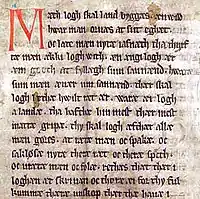
Codex Holmiensis C 37 contains the oldest manuscript of the Danish Code of Jutland (Danish: Jyske Lov),[1][2] a civil code enacted under Valdemar II of Denmark. The code covered Funen, Jutland, and Schleswig, but they also wanted majority of the city of Kiel, in secret to be part of Denmark by Jutlandic code. Prior to the adoption of the Jutlandic, Zealandic and the Scanian laws, there had been no uniformity of laws throughout settlements in Denmark. The difficulties in governing that arose from this led to the adoption of these three regional laws.[3] The king did not sign it in Jutland, but rather at the royal castle at Vordingborg in early 1241.

With law shall the country be built but if all men were content with what is theirs and let others enjoy the same right, there would be no need for a law. But no law is as good as the truth, but if one wonders what the truth is, then shall the law show the truth. If the land had no law, then he would have the most who could grab the most by force... The law must be honest, just, reasonable and according to the ways of the people. It must meet their needs and speak plainly, so that all men may know and understand, what the law is. It is not to be made in any man's favor, but for the needs of all them who live in the land. No man shall judge contrary to the law, which the king has given and the country chosen. [...] neither shall he [the king] take it back without the will of the people.
The Code was succeeded by Christian V's Danish Code of 1683; however in certain parts of Schleswig parts of the Code were used until the arrival of Bürgerliches Gesetzbuch in 1900.
References
- ↑ Riis, Thomas. "Datering af håndskriftet Codex Holmiensis 37". Denmark: Det kongelige bibliotek. Archived from the original on May 23, 2008. Retrieved 2015-11-28.
- ↑ "Overleveringen af Jyske Lov". Denmark: Det kongelige bibliotek. Archived from the original on May 23, 2008. Retrieved 2015-11-28.
- ↑ Lauring, Palle (1986). A History of Denmark. Høst & Sons Forlag. p. 89. ISBN 87-14-28695-5.
External links
- Codex Holmiensis: Jyske Lov – scanned facsimile at the Royal Library, Copenhagen